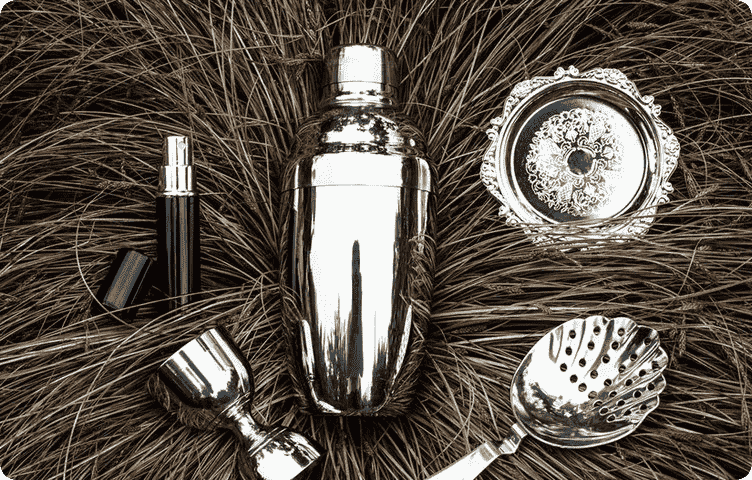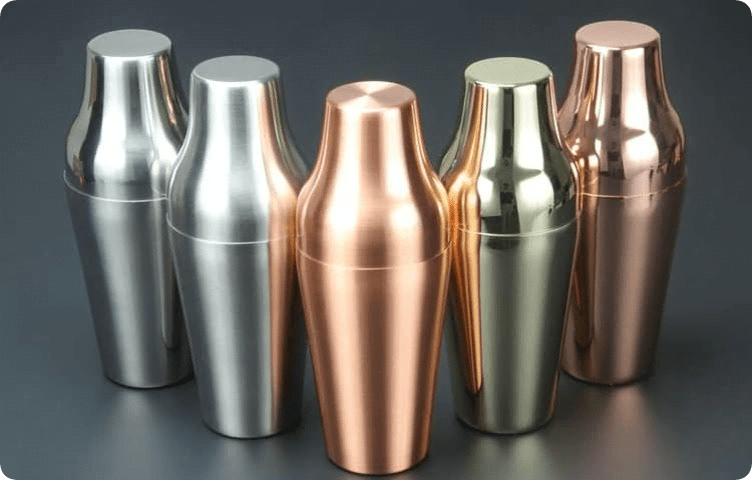A shaker is one of the main tools of a bartender. For the majority, this is exactly how the associative series develops - the bartender stands behind the counter and in his hands is a brilliant miracle that makes divine drinks.
The “shake” method is intended for mixing and cooling difficult-to-mix components, such as syrups, liqueurs, milk, cream, etc.
The main essence of the shaker is intensive whipping, when liquids interact with each other and ice, resulting in a homogeneous drink texture.
History of the cocktail shaker
The first vessels for mixing drinks were used by the ancient Egyptians, the shaker in the form to which modern people are accustomed appeared at the beginning of the 19th century, and Prohibition in America in the 20s of the last century forced many bartenders to master the skill of mixology, and therefore the necessary inventory. Also in the mid-20th century, “home bars” were popular in the states, and every decent housewife had a shaker with a small spout, where they prepared cocktails with tea.
How to choose the right one
There are three main types of shakers: the American Boston shaker , the European Cobbler and the French shaker . Depending on their work skills, speed, and volume of the required drink, bartenders can use any of them. Each shaker has both its pros and cons, so let's take a closer look at each of them.
Boston Shaker

It consists of two bases - a large one and a smaller one. The large one is for ice, and the small one is for cocktail ingredients. The essence of the work is quite simple - ice is poured into one base, the components of a mixed drink into another, and the liquid is carefully poured into a container with ice, then it is fixed with a light tap, and you can start whipping. Boston can be made of two metal bases or of metal and glass. There are also often modifications with additional silicone protection to reduce contact of cold metal with the skin of the hands.
You need to understand that modern bartenders often prefer a completely metal Boston, since the metal has excellent thermal conductivity and cools the cocktail better and faster. But the glass base also has its advantages - the ability to see the volume of the drink and influence its color.
Cobbler

European shaker, standard, traditional, cobbler - these are all different names for the same equipment. The cobbler consists of three parts: a base, a top part with a built-in sieve (small holes) and a miniature lid.
The principle of preparing drinks in a cobbler is as follows: pour ice into the larger part, pour in all the ingredients, close and mix.
 Important point! It is always necessary to close the sieve first, and then the lid, since in the case when the sieve is immediately closed with a lid, an air gap remains, due to which the shaker can open during whipping.
Important point! It is always necessary to close the sieve first, and then the lid, since in the case when the sieve is immediately closed with a lid, an air gap remains, due to which the shaker can open during whipping.A European shaker can be all metal, glass, plastic, or have a glass (or sometimes even crystal) base and a metal lid on top.
French

Perhaps the most refined and sophisticated in form, like everything French.
The French shaker is all about smooth lines, great design and cooking aesthetics. French consists of two metal bases: ice is poured into the larger one, and cocktail components are poured into the smaller one, then the components are poured into ice and mixed. The technique resembles “Boston”, but in operation it is not so. In the “Boston”, the base is fixed with a deviation, forming an angle of resistance, which easily allows you to open the shaker with a careful blow to the desired point, while the French one – tightly, at a right angle, fixes the bases and in the case of intensive whipping, fetters the metal and difficulties arise with opening.
Almost always, a French shaker is made of metal.
Shaker techniques
Dry shake – a dry shake (as whipping without ice is commonly called) is designed to form voluminous foam. Typically, use a dry shake to beat the egg white by placing it in a shaker and shaking vigorously until the desired texture is achieved.
Hard shake – intense/strong shake. Necessary when working with complexcomponents or to form a creamy, foamy structure of the drink. The hard shake is performed a little longer and with more intense movements.
Double shake – double shake. This is the name given to the work of a bartender with two shakers at the same time. In establishments where there is a lot of traffic and a large number of drinks, you can often see a bartender with two shakers at once. This work is quite difficult, but it definitely reduces the time it takes to serve drinks, and also demonstrates the skill of the bartender.
Frowling is a “transfusion” technique. In fact, frawling is already a cousin of the shake, because here we are no longer talking about intense whipping; in this technique, the drink is smoothly poured from one container (part of the shaker) to another. This method allows you to perfectly cool the drink without diluting it with melt water, and the high stream of pouring allows you to aerate the cocktail and achieve an enveloping structure of the drink.
Rolling is a technique similar to fowling. The main difference is only in reducing the distance from one container to another. That is, aeration (saturation of the liquid with oxygen) is minimal.
How to use a cocktail shaker

You can mix almost anything in a shaker, except for two things: hot and carbonated. In the case of hot drinks, the bartender is the first to be injured, since the metal has excellent thermal conductivity. The hot liquid inside will immediately heat up the walls of the shaker and as soon as the bartender takes it in his hands, he is guaranteed to receive a serious burn.
As for carbonated liquids, it’s worth imagining a bottle of tarragon or duchess, which you shook thoroughly and then decided to open. When whipped, the carbonation intensifies, and the shaker will open right in the hands of the bartender, generously giving the cocktail to him, the walls of the bar and, God forbid, the guests sitting next to him.
Therefore, remember strictly! No soda or hot in a shaker!
How to care for your shaker
The shaker should always be clean and dry. After preparing a cocktail, be sure to wash the shaker under running water. The shaker can only be stored in an open (disassembled) form to avoid stagnant odors. It is unacceptable to use glass parts of the shaker that have chips, cracks, or manufacturing defects. Every bartender must check his equipment before work to avoid unpleasant incidents and injuries.
Shaker Substitutes
And as always, it’s worth talking about how to replace something that was invented more than a hundred years ago. We bring to your attention several life hacks, tested, alas, by our own experience:
- Sports shaker. It will perfectly cope with all the tasks of its relative, only the content will differ: instead of banana protein, feel free to mix a daiquiri; - kitchen whisk. Yes, aesthetics are undoubtedly lost, but achieving a uniform taste is quite possible;
- Blender. Sometimes, when you need to prepare a large number of cocktails in a shaker, a bartender can resort to this simplification of the workflow to deliver drinks faster. The only thing, remember that all the ice that ends up in the blender will be completely crushed, therefore, in order not to disturb the structure of the drink, you only need a few cubes for cooling, otherwise you will end up with a Frozen cocktail, and that’s a completely different story;
- Stir in a glass. This is an extreme case when there is nothing at hand. You need to stir well so that the components can dissolve into each other and give, more or less, a decent structure.
And, of course, remember: there are a great many mixing techniques, types of shakers, and professional opinions. Study, listen to everything, but remember that your personal experience, your mistakes and broken glasses are the most important indicators that make up professionalism.
















































/https%3A%2F%2Fcomplexbar.com%2Fimages%2Fblog%2F243%2Fkak-vzbivat-sheikerom.jpg)
/https%3A%2F%2Fcomplexbar.com%2Fimages%2Fblog%2F246%2Funiforma-barmena.jpg)
/https%3A%2F%2Fcomplexbar.com%2Fimages%2Fblog%2F246%2Fkak-nanyat-barmena.jpg)
/https%3A%2F%2Fcomplexbar.com%2Fimages%2Fblog%2F246%2FMadler.jpg)
/https%3A%2F%2Fcomplexbar.com%2Fimages%2Fblog%2F246%2F2024-04-09_17.22.54.jpg)
/https%3A%2F%2Fcomplexbar.com%2Fimages%2Fblog%2F246%2F2024-04-09_17.22.47.jpg)
/https%3A%2F%2Fcomplexbar.com%2Fimages%2Fblog%2F246%2FCODE_anons_foamydrops_752%D1%85480_eng.jpg)
/https%3A%2F%2Fcomplexbar.com%2Fimages%2Fblog%2F246%2FAlina_752%D1%85480_eng.jpg)
/https%3A%2F%2Fcomplexbar.com%2Fimages%2Fblog%2F246%2F2024-04-09_17.23.22.jpg)
/https%3A%2F%2Fcomplexbar.com%2Fimages%2Fblog%2F246%2F2024-04-09_17.23.28.jpg)
/https%3A%2F%2Fcomplexbar.com%2Fimages%2Fblog%2F246%2F2024-04-09_17.23.35.jpg)
/https%3A%2F%2Fcomplexbar.com%2Fimages%2Fblog%2F246%2Fdrinksome_752%D1%85480_eng.jpg)
/https%3A%2F%2Fcomplexbar.com%2Fimages%2Fblog%2F246%2Fnude_752%D1%85480_eng.jpg)
/https%3A%2F%2Fcomplexbar.com%2Fimages%2Fblog%2F246%2F752%D1%85480_eng__1_.jpg)
/https%3A%2F%2Fcomplexbar.com%2Fimages%2Fblog%2F246%2F752%D1%85480_eng.jpg)
/https%3A%2F%2Fcomplexbar.com%2Fimages%2Fblog%2F246%2FStudioRaw_752%D1%85480_eng.jpg)
/https%3A%2F%2Fcomplexbar.com%2Fimages%2Fblog%2F246%2FDoppio_tea_752%D1%85480_eng.jpg)
/https%3A%2F%2Fcomplexbar.com%2Fimages%2Fblog%2F246%2FTognana_Stars_Stripes_752%D1%85480_eng.jpg)
/https%3A%2F%2Fcomplexbar.com%2Fimages%2Fblog%2F246%2FRona_752%D1%85480_eng.jpg)
/https%3A%2F%2Fcomplexbar.com%2Fimages%2Fblog%2F246%2FDoppio_vending_752%D1%85480_eng.jpg)
/https%3A%2F%2Fcomplexbar.com%2Fimages%2Fblog%2F246%2FEssence_sukhie_smesi_752%D1%85480_eng.jpg)
/https%3A%2F%2Fcomplexbar.com%2Fimages%2Fblog%2F246%2FODK_sukhie_smesi752%D1%85480_eng.jpg)
/https%3A%2F%2Fcomplexbar.com%2Fimages%2Fblog%2F246%2Funiforma-barmena.jpg)
/https%3A%2F%2Fcomplexbar.com%2Fimages%2Fblog%2F246%2Fkak-nanyat-barmena.jpg)
/https%3A%2F%2Fcomplexbar.com%2Fimages%2Fblog%2F246%2Fsirop_scale_2400.jpeg)
/https%3A%2F%2Fcomplexbar.com%2Fimages%2Fblog%2F246%2FPeugeot_Anons_Paris_U%27Select_Line_Daman_752%D1%85480_eng.jpg)
/https%3A%2F%2Fcomplexbar.com%2Fimages%2Fblog%2F246%2Fkofe-vostochniy.jpg)
/https%3A%2F%2Fcomplexbar.com%2Fimages%2Fblog%2F246%2FMadler.jpg)
/https%3A%2F%2Fcomplexbar.com%2Fimages%2Fblog%2F246%2Fprofbartender_glavn.jpeg)